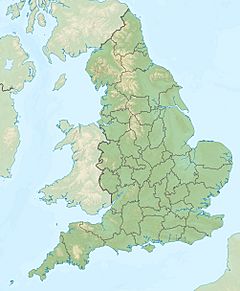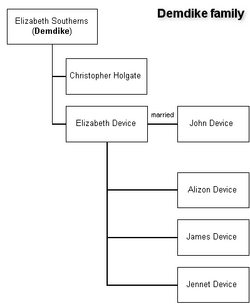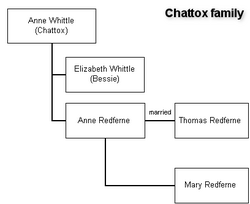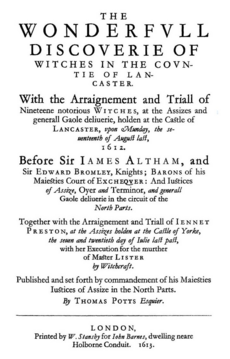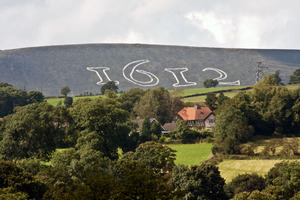Pendle witches facts for kids
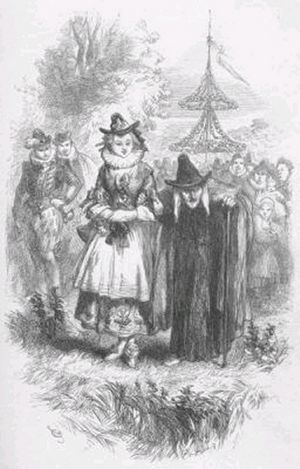
The Pendle witches were a group of people accused of witchcraft in 1612. Their trials are some of the most famous in English history. They are also among the best recorded from the 1600s.
Twelve people were accused. They lived near Pendle Hill in Lancashire, England. They were charged with causing the deaths of ten people using witchcraft. Most of them were tried in Lancaster in August 1612. One person was tried in York. Another person died in prison before their trial.
Out of the eleven people who went to trial, ten were found guilty. They were executed by hanging. One person was found not guilty. These trials were unusual because so many people were hanged at once. Experts believe that fewer than 500 people were executed for witchcraft in England between the 1400s and 1700s. The Pendle trials account for more than two percent of that total.
Six of the accused Pendle witches came from two main families. These families were led by older women in their eighties. One family included Elizabeth Southerns (also known as Demdike), her daughter Elizabeth Device, and her grandchildren James and Alizon Device. The other family included Anne Whittle (also known as Chattox) and her daughter Anne Redferne.
Other people accused were Jane Bulcock, John Bulcock, Alice Nutter, Katherine Hewitt, Alice Grey, and Jennet Preston. Some people in the Pendle area worked as traditional healers. They used herbal medicine and special talismans. This might have made them targets for witchcraft accusations. Many accusations came from the Demdike and Chattox families accusing each other. They might have been competing for business as healers.
Contents
Why the Pendle Witch Trials Happened
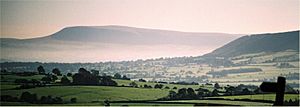
The accused witches lived near Pendle Hill in Lancashire. In the late 1500s, authorities saw Lancashire as a wild area. The local people had strong Roman Catholic beliefs. This was even after King Henry VIII closed the nearby Whalley Abbey in 1537.
When Queen Elizabeth I became queen in 1558, Catholic priests had to hide. But in places like Pendle, they still held secret church services. In 1562, Elizabeth I passed a law against witchcraft. This law said that if witchcraft caused harm, the person could be put to death. Lesser offenses meant time in prison.
King James I and Witchcraft Laws
When Elizabeth I died in 1603, King James I became king. He was very interested in witchcraft. He believed that Scottish witches had plotted against him. In 1597, he wrote a book called Daemonologie. This book told his followers to report and prosecute anyone practicing witchcraft.
One year after James became king of England, a new law was passed. It made witchcraft a crime punishable by death if it caused harm. It also made it a crime to dig up bodies for magic. However, King James was sometimes doubtful about evidence in witch trials. He even found mistakes in some testimonies.
In early 1612, local officials in Lancashire were told to list people who refused to attend the English Church. This was a crime at the time. Roger Nowell was a local judge for Pendle. It was during this search for religious nonconformists that Nowell started investigating witchcraft.
The Start of the Investigation
The investigation began in March 1612. A pedlar named John Law claimed he was injured by witchcraft. Many people accused later believed they were witches. They saw themselves as village healers who used magic for money. Such healers were common in England during the 1500s.
The judges for the trials were Sir James Altham and Sir Edward Bromley. They might have found it hard to understand King James's views on witchcraft. The judges might have wanted to please the King. They may have thought that getting convictions would help their careers.
Events Before the Trials
One of the accused, Demdike, had been known as a witch for 50 years. Some deaths blamed on witches had happened many years before 1612. The event that started the investigation happened on March 21, 1612.
Demdike's granddaughter, Alizon Device, met a pedlar named John Law. She asked him for some pins. Pins were expensive back then and used for magic, like healing warts. It's unclear if Alizon wanted to buy them or was begging.
According to a book from 1613, Alizon said she saw Law stumble and fall. He seemed to become lame. This might have been because he had a stroke. Law didn't accuse Alizon at first. But Alizon seemed to believe in her own powers. When Law's son took her to visit his father, she reportedly confessed. She asked for his forgiveness.
First Accusations
Alizon Device, her mother Elizabeth, and her brother James were called before Judge Nowell. Alizon confessed that she had asked the Devil to make John Law lame. James said his sister also confessed to bewitching a child. Elizabeth only admitted that her mother, Demdike, had a mark on her body. Many people believed such marks were left by the Devil.
Alizon then accused Anne Whittle (Chattox), the leader of another family linked to witchcraft. There might have been bad feelings between the two families. Alizon accused Chattox of killing four men and her father, John Device, using witchcraft. She claimed her father was so scared of Chattox that he paid her oatmeal each year for protection.
On April 2, 1612, Demdike, Chattox, and Chattox's daughter Anne Redferne were called before Nowell. Both Demdike and Chattox were blind and in their eighties. They both made confessions that harmed their cases. Demdike said she gave her soul to the Devil 20 years ago. Chattox said she gave her soul to "a Thing like a Christian man." She claimed he promised her anything she wanted.
Anne Redferne did not confess. But Demdike said she saw Redferne making clay figures. Another witness claimed her brother died after arguing with Redferne. He had blamed Redferne for his illness. Based on this evidence, Nowell sent Demdike, Chattox, Anne Redferne, and Alizon Device to Lancaster Gaol. They would be tried for causing harm by witchcraft.
The Malkin Tower Meeting
The story might have ended there. But Elizabeth Device organized a meeting at Malkin Tower, the Demdike family home. This happened on April 10, 1612. To feed everyone, James Device stole a neighbor's sheep.
Friends and supporters of the family attended the meeting. When Judge Nowell heard about it, he investigated. On April 27, 1612, an inquiry was held. As a result, eight more people were accused of witchcraft. They were Elizabeth Device, James Device, Alice Nutter, Katherine Hewitt, John Bulcock, Jane Bulcock, Alice Grey, and Jennet Preston.
Jennet Preston lived in Yorkshire, so she was sent to York for trial. The others were sent to Lancaster Gaol. Malkin Tower is thought to have been near Newchurch in Pendle. It was likely torn down soon after the trials.
The Witch Trials
The Pendle witches were tried alongside other accused witches. These included the Samlesbury witches and Margaret Pearson. Some of the Pendle witches, like Alizon Device, seemed to believe they were guilty. Others said they were innocent until the end. Jennet Preston was the first to be tried.
York Assizes, July 27, 1612
Jennet Preston lived in Gisburn, Yorkshire. So she was tried at York. Her judges were Sir James Altham and Sir Edward Bromley. Jennet was accused of killing a local landowner, Thomas Lister, by witchcraft. She said she was not guilty. She had been accused of killing a child by witchcraft in 1611 but was found not guilty.
James Device had told Judge Nowell that Jennet attended the Malkin Tower meeting. He claimed she was seeking help with Lister's murder. Jennet was found guilty and sentenced to death by hanging. Her execution happened on July 29, 1612.
Lancaster Assizes, August 18–19, 1612
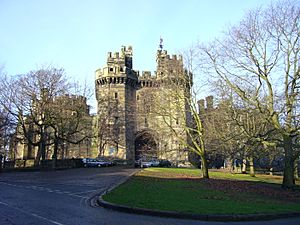
All other accused people lived in Lancashire. They were sent to Lancaster for trial. The judges were Altham and Bromley again. The prosecutor was Roger Nowell, who had gathered the statements.
Nine-year-old Jennet Device was a very important witness. She testified against her mother, brother, and sister. Normally, a child's testimony might not be allowed. But King James had said that normal rules could be bent for witchcraft trials.
Nine of the accused were found guilty. They were Alizon Device, Elizabeth Device, James Device, Anne Whittle, Anne Redferne, Alice Nutter, Katherine Hewitt, John Bulcock, and Jane Bulcock. They were hanged in Lancaster on August 20, 1612. Elizabeth Southerns (Demdike) died in prison before her trial. Only one person, Alice Grey, was found not guilty.
The Book About the Trials
Almost everything we know about the trials comes from a book. It was written by Thomas Potts, the clerk for the Lancaster trials. The judges asked Potts to write his account. He finished it by November 1612. Judge Bromley reviewed and corrected the book before it was published in 1613. He said it was "truly reported."
The book is called The Wonderfull Discoverie of Witches in the Countie of Lancaster. It seems like a word-for-word record. But it actually reflects what happened, not exactly what was said. Still, it gives a generally reliable account of a witchcraft trial.
The trials happened less than seven years after the Gunpowder Plot. This was a plan to blow up the Houses of Parliament and kill King James. It was claimed that the Pendle witches also planned to blow up Lancaster Castle. But some historians think this "ridiculous scheme" was made up by the judges. It might have been agreed to by James Device in his statement. Potts dedicated his book to Thomas Knyvet, the man who caught Guy Fawkes from the Gunpowder Plot.
What Happened Later
Judge Altham continued his career until he died in 1617. Judge Bromley got a promotion in 1616. Thomas Potts was given a park by King James in 1615.
Jennet Device, who testified against her family, might have been accused of witchcraft later. A woman with her name was tried in Lancaster in 1634. It's not certain if it was the same Jennet. The charge was murder by witchcraft. The main witness was a ten-year-old boy. Most of the accused were found guilty. But the judges sent the case to King Charles I. The boy later admitted he made up his evidence. Four people were pardoned, but they stayed in prison and likely died there.
Today, the Pendle witches are a big part of the area's tourism. Local shops sell witch-themed gifts. A brewery makes a beer called Pendle Witches Brew. There's a Pendle Witch Trail from the Pendle Heritage Centre to Lancaster Castle. The X43 bus route is even called "The Witch Way." Some buses are named after the witches.
Pendle Hill is still linked to witchcraft. People gather there every Halloween. Experts say that the Pendle witches have become like folk heroes. Their story is now seen as a symbol of resistance for those who feel left out.
In 1998, a request was made to pardon the witches. But their convictions were not overturned. Another request was made ten years later for Chattox and Demdike. This followed a pardon in Switzerland for a woman executed as a witch in 1782.
Stories and Media About the Witches
Victorian writer William Harrison Ainsworth wrote a romantic novel about the Pendle witches. It was called The Lancashire Witches (1849). It has never been out of print. British writer Robert Neill also wrote about the events in his 1951 novel Mist over Pendle. Poet Blake Morrison wrote poems about them in 1996. Poet Simon Armitage narrated a 2011 documentary called The Pendle Witch Child.
The novel Good Omens by Terry Pratchett and Neil Gaiman has witch characters named after the original Pendle witches. These include Agnes Nutter and Anathema Device. Neil Gaiman confirmed this connection in 2016.
The novel The Familiars (2019) by Stacey Halls also features historical figures from the trials. It focuses on a noblewoman who gets involved in the trial of her midwife, Alice Gray.
400th Anniversary in 2012
Many events marked the 400th anniversary of the trials in 2012. There was an exhibition at Gawthorpe Hall. A music piece called The Fate of Chattox was performed.
A life-size statue of Alice Nutter was put up in her home village, Roughlee. In August, a world record was set. 482 people dressed as witches walked up Pendle Hill. The date "1612" was displayed on the hill using large numbers. The local bishop objected to this. He saw it as a light-hearted celebration of injustice.
New books were published in 2012. These included The Daylight Gate by Jeanette Winterson and Malkin Child by Livi Michael. Blake Morrison also published a poetry book.
See also
- Bideford witch trial
- Cunning folk


